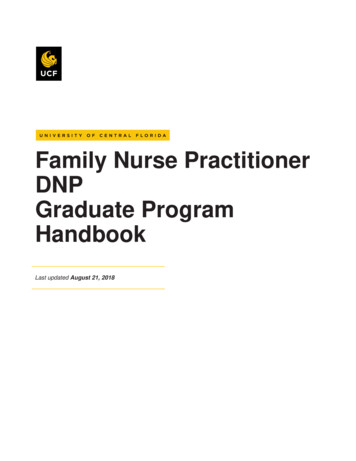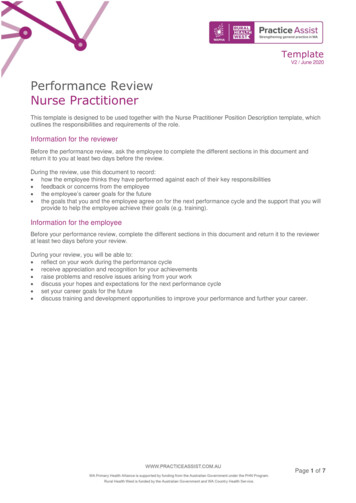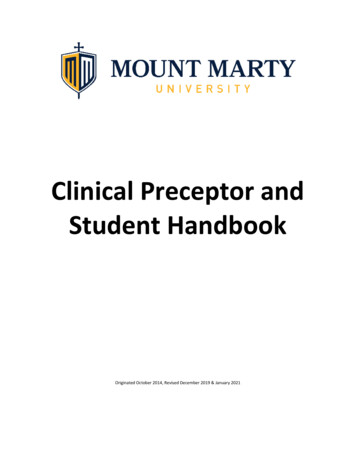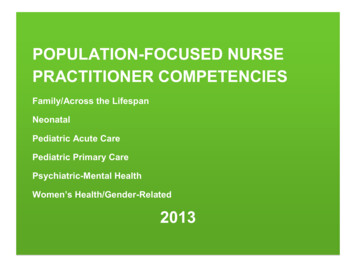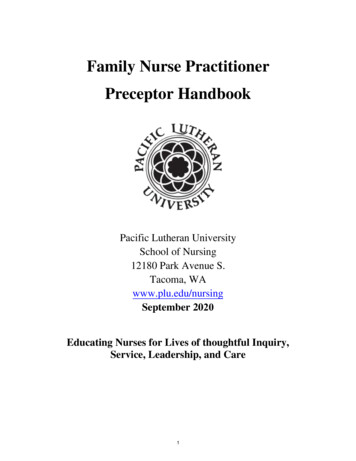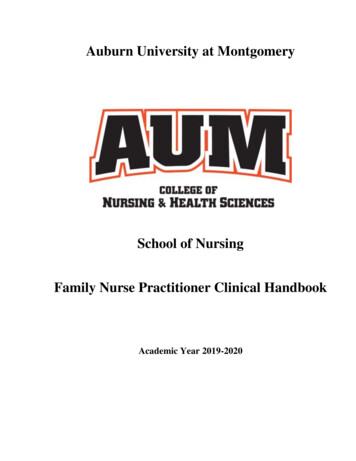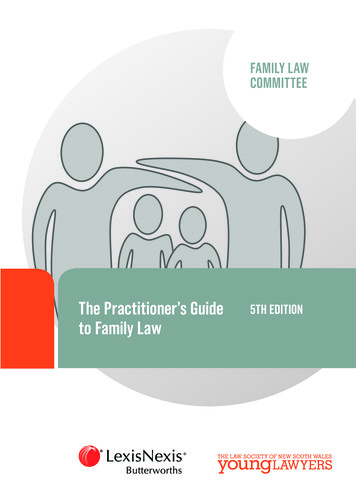
Transcription
FAMILY LAWCOMMITTEEThe Practitioner’s Guideto Family Law5TH EDITION
A Practitioner’s Guideto Family Law5th edition
A Practitioner’s Guideto Family Law5th edition The Law Society of New South Wales(New South Wales Young LawyersFamily Law Committee)2015
A Practitioner’s Guide to Family Law5th EditionPublished by:NSW Young Lawyers170 Phillip Street,Sydney NSW 2000DX 362 SydneyT: 9926 0270F: 9926 0282E: sclaimer: This publication provides general information of an introductory nature and is notintended and should not be relied upon as a substitute for legal or other professional advice. Whileevery care has been taken in the production of this publication, no legal responsibility or liability isaccepted, warranted or implied by the authors or The Law Society of New South Wales (NSW YoungLawyers) and any liability is hereby expressly disclaimed. 2015 The Law Society of New South Wales (NSW Young Lawyers), ACN 000 000 699, ABN 98696 304 966.Except as permitted under the Copyright Act 1968 (Cth), no part of this publication may be reproducedwithout the specifi c written permission of The Law Society of New South Wales.ISBN: 9780409343571
Table of ContentsAbout This GuideAbout NSW Young Lawyers and the NSW Young LawyersFamily Law CommitteeAcknowledgmentsLetter of RecommendationAbbreviationsPart IA Practical Approach to Family Law Practiceviiixxixiiixv1Chapter 1Overview of Family Law PracticeChapter 2Before You File and Case Preparation13Chapter 3Commencing Proceedings23Chapter 4Legal Skills: in General and Specific to Family Law34Chapter 5In the Court49Chapter 6Dispute Resolution71Chapter 7Family Violence78Chapter 8After Court: Finalising a Matter95Chapter 9Varying and Setting aside Orders99Part IIGeneral Principles of Family Law3109Chapter 10 Parenting111Chapter 11 Property159Chapter 12 Child Support181Chapter 13 Maintenance195Chapter 14 Divorce201Chapter 15 Contravention and Enforcement206v
A Practitioner’s Guide to Family LawChapter 16 International Aspects of Family Law231Chapter 17 Surrogacy236Chapter 18 Appeals and Reviews239Chapter 19 Costs248Index261vi
About This GuideThis is a project of the NSW Young Lawyers Family Law Committee.This publication is designed as a guide for legal practitioners and to provideinformation only and not to provide legal advice.It is aimed at young lawyers learning about practising family law in New SouthWales and for those practitioners who do not regularly practice in family law.The Guide is particularly focused on the practical aspects of family law procedureand everyday practice in New South Wales.It is not a textbook, nor a comprehensive guide on any particular topic, but shouldbe used as a good starting point when appearing in the Family Court of Australiaor Federal Circuit Court of Australia.The law is at August 2015.The practice and procedure of the Family Court of Australia and the FederalCircuit Court of Australia referred to in the Guide is also current as at August2015 and is based primarily on experience in the Sydney Registry. Both courts areundertaking significant procedural changes on a regular basis. Accordingly, whileaccurate at the time of writing, further changes are likely.An electronic version of the Guide is also available through the NSW YoungLawyers website.Jennifer HyattChair of the Practitioner’s Guide to Family Law SubcommitteeSeptember 2015vii
About NSW Young Lawyersand the NSW Young LawyersFamily Law CommitteeNSW Young Lawyers (NSWYL), a division of the Law Society of NSW, is a forumfor young lawyers in NSW to initiate and express fresh ideas and directions oflegal and social issues for the benefit of the profession and the community.It represents lawyers who are under 36 years of age or who have been admitted topractice for less than 5 years, and law students.The objects and purposes of NSWYL include to: further the interests and objectives of lawyers in NSW; challenge the views of the day having regard to the interests and rights ofyoung people; and promote the benefit of the community and disadvantaged groups.NSWYL Family Law CommitteeThe NSWYL Family Law Committee (the Family Law Committee) was formedin April 2000 and was established to give Young Lawyers and students who areinterested in or want to practice in Family Law a forum to share their views andnews.The Family Law Committee is a dynamic group of professionals, includinglawyers from private practice, the court, Legal Aid and community organisations.Our members are law students, legal practitioners or court associates under theage of 36 or in their first 5 years of practice.This Guide has been written by members of the Family Law Committee.The aims of the Family Law Committee are to: provide professional education in family law for the whole profession byorganising CLE seminars as part of the NSWYL CLE Program, includingour Confidence in the Courtroom Program and Annual One Day CLE;ix
A Practitioner’s Guide to Family Law proactively monitor and have input into changes in family law, includingcommenting on proposed legislation, and making submissions togovernments, courts and other organisations on various issues relevantto family law as they arise; organise meetings, seminars, publications and public forums on issuesrelating to family law; provide a forum for young practitioners to discuss issues of concern tothem; provide a peer support network for young practitioners and practitionersin the first 5 years of practice involved in family law; promote issues which are of relevance and concern to young lawyers; and promote NSWYL’s activities and enhance the image of NSWYL.We welcome new members. If you are interested in joining the FamilyLaw Committee or have any questions please contact our committee chair,Anna Domalewski, at flaw.chair@younglawyers.com.au .We also invite you to follow us on Facebook at www.facebook.com/nswylflaw .Anna DomalewskiChair of the Family Law CommitteeSeptember 2015x
AcknowledgmentsManaging EditorsAnna DomalewskiJennifer HyattKiel RobertsCurrent ContributorsLotte CallananLouise CooneyAnna DomalewskiYan GaoSarah HendryJennifer HyattKate MacdonaldHarry McDonaldNatalie MoffetJacqueline NavinDeena PalethorpeKiel RobertsA special thank you to our immediate past Chair, Antonia Fontana, for her workon A Practitioner’s Guide to Family Law.Past Contributors including, but not limited to, past managing editors andcontributors of the 4th edition, namely: Olivia Conolly, Antonia Fontana, VanessaJackson, Ann Leonard, Collette McFawn, Sasha More, Kelly Batey, Tom Butlin,Leah Georgakis, Cristine Huesch, Madeline Joel, Natasha Jones, Anna Leonard,Lisa Molloy, Mary Snell, Celia Oosterhoff, Michelle Osbourne, Christopher Paul,Sharda Ramjas, Vaughan Roles, Anne Taylor and Tri Tran.xi
A Practitioner’s Guide to Family LawA special thanks to our reviewersBelinda Crawford, Registrar of the Family Court of AustraliaEleanor Lau, Senior Associate, Watts McCray LawyersJohn Longworth, Barrister, Frederick Jordan ChambersCollette McFawn, Partner, Watts McCray LawyersCarly Mirza-Price, Senior Associate, Mills Oakley LawyersCatherine Parks, Senior Associate, Turner Freeman LawyersAnnelise Pedersen, Director, Broun Abrahams Burreket Family LawyersShelby Timmins, Senior Associate, Barkus Doolan Family LawyersJacqueline Vincent, Partner, Watts McCray LawyersThanksNSW Young LawyersLexisNexis AustraliaPrevious NSW Young Lawyer Family Law CommitteesSincere apologies to those who have been inadvertently omitted.xii
Letter of Recommendationxiii
AbbreviationsAATAdministrative Appeals TribunalADVOApprehended Domestic Violence OrderAFPAustralian Federal PoliceAVOApprehended Violence OrderBDMNSW Registry of Births, Deaths and MarriagesCACCase Assessment ConferenceCDCChild Dispute ConferenceCDPVACrimes (Domestic and Personal Violence) Act 2007 (NSW)CICChild Inclusive ConferenceCSAChild Support AgencyCSAAChild Support (Assessment) Act 1989 (Cth)CSRChild Support RegistrarCSRCAChild Support (Registration and Collection) Act 1988 (Cth)FACSDepartment of Family and Community ServicesFamily Court Family Court of AustraliaFCCFederal Circuit Court Of AustraliaFCCRFederal Circuit Court Rules 2001 (Cth)FDRFamily Dispute ResolutionFLAFamily Law Act 1975 (Cth)FLRFamily Law Rules 2004 (Cth)ICLIndependent Children’s LawyerPINOPPerson in Need of Protectionxv
Part IA Practical Approach toFamily Law Practice
Chapter 1Overview of Family LawPracticeJurisdiction1.1 The Commonwealth and the states each have power to legislate in respectof certain areas of family law. In relation to the Commonwealth, s 51 of theConstitution provides:The Parliament shall, subject to the Constitution, have power to make laws for thepeace, order, and good government of the Commonwealth with respect to: marriage; divorce and matrimonial causes; and in relation thereto, parental rights,and the custody and guardianship of infants.1.2 New South Wales, along with four other states, handed the Commonwealththeir power to legislate with respect to children. The specific referral of powerin relation to children includes the power to make laws regarding maintenanceof children, guardianship, residence, contact (referred to as ‘live with’ and ‘spendtime’) and parentage issues.Marriage1.3 Section 4 of the Family Law Act 1975 (Cth) (FLA) sets out what constitutes‘matrimonial cause’. It includes divorce, declarations as to the validity of a marriageor divorce, maintenance, property and financial or maintenance agreements.1.4 Section 39 of the FLA sets out the requirements for commencing proceedingsunder the FLA.3
A Practitioner’s Guide to Family Law1.5 In respect of divorce proceedings a party to a marriage may commenceproceedings under the FLA if either party is an Australian citizen, domiciled inAustralia or ordinarily resident in Australia for at least the past 1 year.1.6 In respect of other proceedings falling under the definition of ‘matrimonialcause’, a party to a marriage may commence proceedings under the FLA if eitherparty is an Australian citizen, domiciled in Australia or ordinarily resident inAustralia at the date of filing.De facto relationships1.7 Section 4AA of the FLA was introduced in 2009 and sets out the meaningof ‘de facto relationship’:(1)A person is in a de facto relationship with another person if:(a)the persons are not legally married to each other; and(b)the persons are not related by family (see subsection (6)); and(c)having regard to all the circumstances of their relationship, they havea relationship as a couple living together on a genuine domestic basis.Paragraph (c) has effect subject to subsection (5). (5)For the purposes of this Act:(a)a de facto relationship can exist between 2 persons of different sexesand between 2 persons of the same sex; and(b)a de facto relationship can exist even if one of the persons is legallymarried to someone else or in another de facto relationship.1.8 In some cases, there can be issues about the length of the de facto relationshipor even the existence of a de facto relationship. For statutory relief, the minimumperiod of cohabitation is 2 years: s 90SB of the FLA.Children1.9 Section 31(1)(v) of the FLA states that the Family Court has jurisdictionover the rights and status of a child and their relationship with their parents.1.10 Unlike de facto or matters falling under matrimonial causes, there is nospecific requirement for the child to be an Australian citizen, resident or domiciledin Australia. However, in practice, except in exceptional or unusual circumstances,the court is unlikely to make orders referable to a child that is not at least residentin Australia.4
Chapter 1: Overview of Family Law PracticeCourts exercising jurisdiction1.11 It is important to understand that there are two Commonwealth courtswhere jurisdiction under the FLA is predominantly exercised: the Family Courtand the FCC. Family law cases filed in the Western Australia are dealt with by theFamily Court of Western Australia.1.12 The following courts exercise jurisdiction under the FLA: Family Court of Australia (Family Court) Federal Circuit Court of Australia (FCC) Courts of summary jurisdiction which, in most cases, will be the LocalCourt.1.13 The Family Court only deals with a small percentage of all first instancefamily law cases. The FCC is considered the trial court and deals with the majorityof family law cases, including both parenting and property. Since the establishmentof the FCC in 2000 there has been a progressive shift in the balance of filingsbetween the two courts, with the majority of all family law parenting cases nowfiled in the FCC. Of course, the Family Court deals with all appeals.1.14 Practitioners should be aware that the Family Court and the FCC havedifferent Rules. You must ensure you comply with the Rules that pertain to thecourt you file in. The Family Law Rules 2004 (Cth) (FLR) are more comprehensivethan the Federal Circuit Court Rules 2001 (Cth) (FCCR). It is important to notethat in the event that the FCCR are silent or deficient, the FLR apply.1.15 An applicant can choose to file an application in either the Family Courtor the FCC. Each of those courts will apply the provisions of the FLA and relevantlegislation, but will differ in their Rules of Court and, therefore, the procedure thatwill be followed in each case.1.16 As the family law system is a national one, it is permissible for an applicantto file in any Family Court or FCC registry within Australia, without regardto geographic location. However, filing an application in a registry that has noobvious connection with the case will invariably result in a successful application(including possibly an order for costs) for change of venue being brought by therespondent.1.17 When preparing your client’s case, the first decision you will need to makeis which court the application should be filed in.5
A Practitioner’s Guide to Family LawFamily Court of AustraliaWebsite: www.familycourt.gov.au Twitter account @FamilyCourtAU Legislation: Family Law Act 1975 (Cth); Family Law Rules 2004 (Cth); FamilyLaw Regulations 1984 (Cth)Chief Justice Diana Bryant AO1.18 The Family Court is a superior court of record which has originaljurisdiction to hear family law matters and also acts as an appeal court fromdecisions of single judges of the Family Court and the FCC.1.19 The jurisdiction of the Family Court is principally outlined in the followingsections of the FLA: original jurisdiction: ss 31(1) and 69H; appellate jurisdiction: s 93A(1); hearing of case stated: s 94A(1); associated matters: s 33; miscellaneous matters: s 39(5); and by proclamations: s 40.1.20 The Family Court also exercises jurisdiction under the following Acts: Marriage Act 1961 (Cth): s 12 (authorisation of marriage of person underage of 18 or 16 years in exceptional circumstances); s 16 (consent bythe court where parent etc refuses to consent etc); s 17 (re-hearing ofapplications by a judge); and s 92 (declaration of legitimacy). Child Support (Registration and Collection) Act 1988 (Cth) (CSRCA)and Child Support (Assessment) Act 1989 (Cth) (CSAA). The CSRCA and the CSAA both confer original and appellate jurisdictionon the Family Court in respect of matters arising under these Acts:ss 104(1) and 106(1) of the CSRCA and ss 99(1) and 101(1) of the CSAA.1.21 The Family Court also has other forms of jurisdiction: implied jurisdiction: all courts of limited jurisdiction have impliedjurisdiction, which is incidental to their statutory jurisdiction. The FamilyCourt has implied power to make orders as are necessary for it to exerciseits statutory jurisdiction with justice and efficiency;6
Chapter 1: Overview of Family Law Practice incorporated jurisdiction: the Rules of the High Court apply to the FamilyCourt, so far as they are capable of application and subject to any directionsof the Family Court concerning practice and procedure. Further, theJudiciary Act 1903 (Cth) provides that state law, and the Australian commonlaw to a limited extent, apply to courts exercising federal jurisdiction; associated jurisdiction: s 33 of the FLA gives the Family Court (but noother court) a broad jurisdiction in respect of matters which are associatedwith other matters within the express jurisdiction of the Family Court; and accrued jurisdiction: non-federal jurisdiction accrues to a court exercisingfederal jurisdiction so that the court may determine the entire matterbefore it and not simply the federal aspects of the matter. Cross-vestedjurisdictional issues arise under this form of jurisdiction.Federal Circuit Court of AustraliaWebsite: www.federalcircuitcourt.gov.au Legislation: Family Law Act 1975 (Cth); Federal Circuit Court Rules 2001(Cth); and, in particular circumstances, Family Law Rules 2004 (Cth) andFamily Law Regulations 1984 (Cth)Chief Judge Pascoe AO CVO1.22 The FCC (known as the Federal Circuit Court since 12 April 2013 andbefore then, the Federal Magistrates Court) was established in July 2000 todeal with a range of less complex federal disputes, including matters arising fordetermination pursuant to the FLA. The objective of the court is to provide asimple and more accessible alternative to litigation in the Family Court and theFederal Court and to relieve the workload of those courts.1.23 The FCC has power to develop procedures which are as streamlined anduser-friendly as possible, with the intention of reducing delay and cost to litigants.As a general rule, the FCC will not list matters which will require more than 3or 4 days of hearing time, so while there is no rule forcing the commencementof less complex proceedings in the FCC, practitioners should exercise somedegree of discretion when deciding in which court to file their client’s application.Occasionally, the court will retain a longer matter because, the complexity of thematter becomes apparent only in the hearing, or it is in the interests of justicefor the court to continue to hear the matters notwithstanding the hearing timerequired. This policy will be applied flexibly by the court.7
A Practitioner’s Guide to Family Law1.24 The FCC is a court of both record and of law and equity and, accordingly,has the power to apply both the rules of law and the rules of equity. It is not asuperior court.1.25 The FCC is the only federal court that regularly conducts regional circuitswith judges based in all capital cities and the regional cities of Cairns, Launceston,Newcastle and Townsville. The court also conducts regular circuits in rural andregional areas.1.26 The jurisdiction conferred on the FCC is concurrent with that of theFamily Court and the Federal Court. That is, the FCC has no exclusive jurisdictionand in some areas its jurisdiction is less extensive than that of the Federal Courtand Family Court.1.27 The jurisdiction of the FCC includes family law, child support,administrative law, bankruptcy, human rights, consumer matters, privacy,migration, intellectual property, industrial law and admiralty law. The court sharesthose jurisdictions with the Family Court and the Federal Court.1.28 In the family law area, the FCC has jurisdiction in the following matters: applications for divorce; dissolution of marriages (but not declarations as to validity of a marriageor of dissolution or annulment of a marriage); declaration and adjustment of property interests, irrespective of value; applications concerning spousal and de facto maintenance propertydisputes; all parenting orders including those providing for where a child lives, andwho a child spends time and communicates with; contravention, maintenance or enforcement of orders made by either theFCC or the Family Court; and child support.1.29 The FCC has no jurisdiction to determine matters relating to adoption orapplications concerning nullity or validity of marriage.Local Courts1.30 Although an applicant may commence proceedings in a Local (state orterritory Magistrates’) Court, that court only has jurisdiction to hear the matter ifthe respondent consents. If proceedings are commenced in the Local Court and8
Chapter 1: Overview of Family Law Practicethe respondent seeks to have the proceedings transferred to the FCC or the FamilyCourt, the Local Court must transfer the proceedings notwithstanding the otherparty does not consent: s 69K of the FLA.1.31 Proceedings cannot be commenced in a Local Court of a territory unless atleast one of the parties to the proceedings is ordinarily a resident of that territorywhen the proceedings are instituted or transferred: s 69K of the FLA.1.32 Unless there is a very good reason to do so, including geographicconvenience and an assurance from the respondent that consent to the court’sjurisdiction will be forthcoming, it is preferable to commence proceedingsin either the Family Court or the FCC. This is because the federal courts arespecialist courts with greater expertise and resources to deal with family lawmatters.1.33 Jurisdiction is also vested by the FLA in courts of summary jurisdiction,such as Local Courts in New South Wales, by the following sections: jurisdiction in respect of all matrimonial causes except proceedings for adecree of nullity of marriage, a declaration as to the validity of a marriageor for the dissolution or annulment of a marriage by decree or otherwise:s 39(6); limits jurisdiction in respect of property proceedings. A property mattercan only be determined if its value does not exceed 20,000. If there is noconsent to the matter proceeding in a court of summary jurisdiction thatcourt must transfer the proceedings to the Family Court or another courtwhich has jurisdiction to hear the matter: s 46(1); and jurisdiction to deal with proceedings under Pt VII of the FLA (children).The court of summary jurisdiction cannot determine contestedproceedings for parenting orders without the consent of the parties: s 69J.The court must transfer the proceedings to a higher court such as theFCC or the Family Court: s 69N(3).1.34 Section 96(1) of the FLA provides that a decision of a court of summaryjurisdiction exercising powers under the FLA can be appealed. An application ismade to the Family Court.1.35 While a Local Court has jurisdiction to deal with a matter, it only hasjurisdiction to make orders pending the transfer of the matter to a Family Courtor FCC, unless the parties consent to the jurisdiction: s 69N(3). Any order madeby a Local Court magistrate can, of course, be appealed, which results in a Hearing9
A Practitioner’s Guide to Family Lawde Novo. While in some cases a great deal can be achieved at a Local Court, inmost contentious and complex matters, it is advisable to commence proceedingsat either the Family Court or FCC.Which court should I file in?1.36 The Family Court deals with the most complex and intractable parentingdisputes requiring substantial court time. These cases often involve allegations ofphysical or sexual abuse of children; family violence; mental health issues andsubstance abuse. Other areas of family law affecting children dealt with by theFamily Court include domestic and international relocation; international childabduction and the Hague Convention; and medical procedures requiring courtauthorisation. The Family Court will also deal with those cases involving complexquestions of jurisdiction or law.1.37 If you have a matter involving allegations of sexual assault, it is advisable tofile in the Family Court and request the matter be referred to the Magellan Judge.1.38 For most young lawyers, the types of matters that you will be dealing withwill almost exclusively be in the FCC.1.39 There is no tactical advantage to filing in the Family Court as opposedto the FCC. If you file in the Family Court and the court is of the view that yourmatter is not sufficiently complex and does not fall in the protocol (see below),your matter will be transferred to the FCC and will not receive any priority.1.40 Although it is very difficult to ascertain estimated hearing times at thecommencement of a matter, if the matter is complex or there are multiple thirdparties involved and is likely to exceed 4 days final hearing, then you should filein the Family Court.Protocol1.41 In January 2010, the Chief Justice of the Family Court and the Chief Judgeof the FCC published a protocol about the division of work between the courts.This is a useful resource in determining which matters should be filed in theFamily Court. Either court can, of its own motion, transfer a matter to the othercourt. There is no right of appeal against a decision to transfer the matter to theother court.10
Chapter 1: Overview of Family Law PracticeProtocol for the division of work between the Family Court of Australia andthe Federal Circuit CourtThe Chief Justice and the Chief Judge have published this Protocol for theguidance of the legal profession and litigants, so as to enable matters to be directedproperly to the court appropriate to hear them. The Protocol may on occasionsgive way to the imperatives of where a case can best be heard and is not intendedto constrain the discretion of a judicial officer having regard to the applicablelegislation and the facts and circumstances of the case before him or her.If any one of the following criteria applies, then the application for final ordersordinarily should be filed and/or heard in the Family Court, if judicial resourcespermit, otherwise the matter should be filed and/or heard in the FCC.1. International child abduction.2. International relocation3. Disputes as to whether a case should be heard in Australia.4. Special medical procedures (of the type such as gender reassignment andsterilisation).5. Contravention and related applications in parenting cases relating to orderswhich have been made in Family Court proceedings; which have reacheda final stage of hearing or a judicial determination and which have beenmade within 12 months prior to filing.6. Serious allegations of sexual abuse of a child warranting transfer to theMagellan list or similar list where applicable, and serious allegations ofphysical abuse of a child or serious controlling family violence warrantingthe attention of a superior court.7. Complex questions of jurisdiction or law.8. If the matter proceeds to a final hearing, it is likely it would take in excess offour days of hearing time.NOTE: The Family Court has exclusive jurisdiction in relation to adoption andthe validity of marriages and divorces.Transfers1. Either court on its own motion or on application of a party can transfer amatter to the other court.2. There is no right of appeal from a decision as to transfer.11
A Practitioner’s Guide to Family LawOther1.42 Delays vary from registry to registry and from court to court and, ifpossible, enquiries should be made prior to filing as to the expected delay periodsin each case. This can affect the decision as to the court and registry in which anapplication should be filed.Reporting and publication of family law matters1.43 Unlike other jurisdictions, very strict rules apply to repeating informationabout family law proceedings and the disclosure of personal or identifyinginformation about parties to family law matters. The FLA restricts how courtproceedings are recorded and what information can be published or broadcast,including on social networking sites. Section 97 of the FLA provides that allproceedings are held in open court unless the court decides otherwise.1.44 Section 121 of the FLA makes it an offence to publish proceedings orimages that identify people involved in family law proceedings unless a PublicationOrder has been made or another s 121 exemption applies. Penalties of up to 1 yearimprisonment can apply for breaches of s 121.12
Chapter 2Before You File and CasePreparationOpening a fileCosts2.1 If you hold a practising certificate in New South Wales, you are bound bythe Legal Profession Uniform Law. This legislation, among other things, placesobligations on legal practitioners in relation to costs. There are also family lawspecific obligations in relation to costs (see, for example, Ch 19 of the FLR andPt 21 of the FCCR). You should read these pieces of legislation and make sure youunderstand your obligations.2.2 To make sure you stay on top of costs, you might want to:read your firm’s Cost Agreement;keep track of any costs estimates sent out on your matters;keep track of any invoices that are sent out on your matters;set up reminders for court events, or other important dates that arecoming up where you may need to provide a written costs disclosure.File management2.3 Proper file management will not only help you feel organised and in controlof your practice, it is also essential for auditing, risk management and providingoptimum service to your clients.2.4 Try to imagine what would happen if you were hit by a bus on your way outto lunch. Would any other lawyer in your office be able to pick up your file and13
A Practitioner’s Guide to Family Lawrun it in your absence? Would they be able to quickly locate any document theymight need? Could they get an idea of the important issues in the matter, withouthaving to read the entire file?2.5 Every firm will have its own way of organising client files. Learn the wayyour firm operates and make sure your files are organised consistently.2.6 There is no right or wrong way to manage your file. These are some thingsyou may want to consider, however, so that you can stay on top of all of yourmatters: Prepare a chronology, or basic outline of case document for each matter.This can be in simple table format, with columns for dates, relevant eventsand your notes, including details of any source material. This should be aliving document that you update as each matter progresses. It can be easilyadapted when you need to file a case outline for mediation or hearing, butis also a great refe
5th Edition Published by: NSW Young Lawyers 170 Phillip Street, Sydney NSW 2000 DX 362 Sydney T: 9926 0270 F: 9926 0282 E: ylgeneral@younglawyers.com.au . Part II General Principles of Family Law 109 Chapter 10 Parenting 111 Chapter 11 Property 159 Chapter 12 Child Support 181


